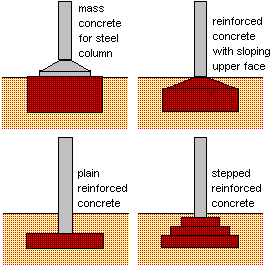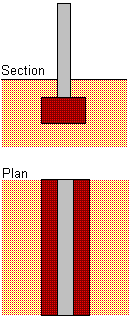- Shallow foundations
- Deep foundations
Deep foundations include piles, pile walls, diaphragm walls and caissons.
Shallow foundations
- Pad foundations
- Strip foundations
- Raft foundations
Shallows foundations are used when surface soils are sufficiently strong and stiff to support the imposed loads; they are generally unsuitable in weak or highly compressible soils, such as poorly-compacted fill, peat, recent lacustrine and alluvial deposits, etc.
Pad foundations
 Pad foundations are used to support an individual point load such as that due to a structural column. They may be circular, square or reactangular. They usually consist of a block or slab of uniform thickness, but they may be stepped or haunched if they are required to spread the load from a heavy column. Pad foundations are usually shallow, but deep pad foundations can also be used.
Pad foundations are used to support an individual point load such as that due to a structural column. They may be circular, square or reactangular. They usually consist of a block or slab of uniform thickness, but they may be stepped or haunched if they are required to spread the load from a heavy column. Pad foundations are usually shallow, but deep pad foundations can also be used.Strip foundations
 Strip foundations are used to support a line of loads, either due to a load-bearing wall, or if a line of columns need supporting where column positions are so close that individual pad foundations would be inappropriate.
Strip foundations are used to support a line of loads, either due to a load-bearing wall, or if a line of columns need supporting where column positions are so close that individual pad foundations would be inappropriate.Raft foundations
Raft foundations are used to spread the load from a structure over a large area, normally the entire area of the structure. They are used when column loads or other structural loads are close together and individual pad foundations would interact.A raft foundation normally consists of a concrete slab which extends over the entire loaded area. It may be stiffened by ribs or beams incorporated into the foundation.
Raft foundations have the advantage of reducing differential settlements as the concrete slab resists differential movements between loading positions. They are often needed on soft or loose soils with low bearing capacity as they can spread the loads over a larger area.
Deep foundations
- Piles
Piles are relatively long, slender members that transmit foundation loads through soil strata of low bearing capacity to deeper soil or rock strata having a high bearing capacity. They are used when for economic, constructional or soil condition considerations it is desirable to transmit loads to strata beyond the practical reach of shallow foundations. In addition to supporting structures, piles are also used to anchor structures against uplift forces and to assist structures in resisting lateral and overturning forces.
Piers are foundations for carrying a heavy structural load which is constructed insitu in a deep excavation.
Caissons are a form of deep foundation which are constructed above ground level, then sunk to the required level by excavating or dredging material from within the caisson.
Compensated foundations are deep foundations in which the relief of stress due to excavation is approximately balanced by the applied stress due to the foundation. The net stress applied is therefore very small. A compensated foundation normally comprises a deep basement.